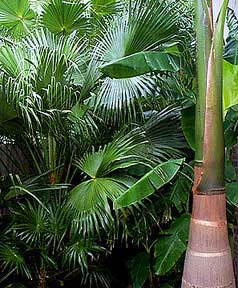Subtropical perennials are a delightful addition to gardens, imbuing them with a sense of exotic allure and year-round splendor. These plants, well-suited to subtropical climates, offer an extensive assortment of textures, colors, and forms that enhance the beauty of any garden landscape. In this article, we will explore the enchanting realm of subtropical perennials, delving into their unique attributes and the benefits they bring to gardening enthusiasts.
Understanding Subtropical Climates
Subtropical climates are characterized by long, balmy summers and mild winters, typically found in regions situated between the tropical and temperate zones. These climatic conditions create an ideal environment for plant growth, providing an abundance of warmth and consistent rainfall throughout the year. The interplay of heat and humidity in subtropical regions profoundly influences the types of plants that thrive in such areas, necessitating a comprehensive understanding of these climatic intricacies for successful gardening endeavors.
Characteristics of Subtropical Perennials
Subtropical perennials possess a captivating array of features that equip them to flourish in their specific climatic niche. Many of these plants exhibit evergreen foliage, ensuring that they maintain their lush appearance throughout the year. The foliage itself encompasses a wide spectrum of textures, ranging from glossy and broad leaves to delicately dissected or feathery foliage. The realm of subtropical perennials also embraces a diverse palette of colors, spanning from vibrant greens and deep burgundies to stunning variegated patterns.
The flowering patterns of subtropical perennials are as diverse as the plants themselves. While some species boast a continuous blooming cycle, others showcase their vibrant flowers during specific seasons. The blooms of these perennials encompass a myriad of hues, ranging from soft pastels to bold and vivid tones, attracting a delightful array of pollinators such as butterflies and bees. Furthermore, many subtropical perennials have evolved unique adaptations to their environment, such as thickened leaves to minimize water loss or waxy coatings that safeguard against the intensity of the sun.
Collectively, subtropical perennials offer an extraordinary range of characteristics that contribute to their allure in garden settings. With their captivating foliage, diverse flower displays, and remarkable adaptations to subtropical conditions, these plants bring both visual delight and perpetual interest to any landscape, ensuring a rewarding gardening experience throughout the changing seasons.
Popular Subtropical Perennial Varieties
When it comes to subtropical perennials, a wide range of options is available to suit different garden preferences and conditions. For those seeking shade-loving varieties, consider plants such as the striking Caladium with its vibrant and variegated foliage or the elegant Bleeding Heart (Dicentra spectabilis) with its heart-shaped flowers dangling from arching stems. If you have sunnier areas, you might consider the bold and resilient Daylilies (Hemerocallis) with their colorful and prolific blooms or the ever-popular Butterfly Bush (Buddleja) known for attracting butterflies and hummingbirds with its fragrant flowers.
In regions where water conservation is a concern, drought-tolerant subtropical perennials offer a solution. Plants like the resilient Lantana produce clusters of vibrant flowers and thrive in hot and dry conditions, while the Mediterranean native Rosemary (Rosmarinus officinalis) not only adds a culinary herb to your garden but also boasts aromatic foliage and delicate blue flowers.
For those looking to explore lesser-known options, consider the unusual Red Torch Ginger (Etlingera elatior) with its dramatic red bracts that resemble a torch, or the tropical-looking Canna Lily (Canna) which offers a stunning display of vibrant flowers in various colors. These unique subtropical perennials can add an exotic touch and become eye-catching focal points in your garden.
Cultivation and Care of Subtropical Perennials
Cultivating subtropical perennials successfully begins with understanding their specific needs. These plants typically thrive in well-draining soil that is rich in organic matter. Adding compost or well-rotted manure during planting or as a top dressing helps enhance soil fertility and moisture retention. Regular watering is crucial, especially during the establishment period, but be cautious of overwatering, as it can lead to root rot. It’s important to strike a balance and provide enough moisture without creating waterlogged conditions.
Fertilization requirements vary depending on the specific perennial and soil conditions. Generally, applying a balanced slow-release fertilizer in early spring and mid-summer can provide the necessary nutrients for healthy growth. However, it’s advisable to refer to specific plant guidelines for accurate fertilization recommendations.
Maintenance practices for subtropical perennials include regular deadheading of spent flowers to encourage continuous blooming and promote a tidy appearance. Some plants may benefit from occasional pruning to control size and shape. Dividing clumps of perennials every few years helps rejuvenate the plants and maintain their vigor.
Designing with Subtropical Perennials
Incorporating subtropical perennials into your garden design offers a myriad of possibilities for creating visually appealing and dynamic landscapes. The key is to consider foliage textures, colors, and plant heights when selecting and placing these plants. Combining different foliage types, such as the broad leaves of Elephant Ears (Colocasia) with the feathery fronds of Ferns, adds contrast and visual interest. Mixing plants with varying heights creates layers and depth, with taller varieties acting as backdrops for shorter ones.
To enhance the overall aesthetic, consider incorporating complementary annuals or shrubs that bloom at different times to provide continuous color throughout the seasons. Combining the vibrant blooms of subtropical perennials with the architectural forms of ornamental grasses or the softness of flowering shrubs can create visually captivating displays.
Additionally, strategically placing subtropical perennials based on their light requirements is crucial. Grouping shade-loving varieties under trees or in shaded areas ensures they receive the necessary protection from the sun. Meanwhile, sun-loving perennials should be positioned in open, sunny spots to maximize their growth and flowering potential.
By carefully selecting and arranging subtropical perennials, you can create a garden that offers a stunning blend of colors, textures, and forms while capitalizing on the unique beauty these plants bring to your outdoor space.
Seasonal Considerations and Year-Round Interest
When incorporating subtropical perennials into your garden design, it’s essential to consider their seasonal characteristics and strive for year-round interest. Some subtropical perennials are renowned for their specific bloom seasons, such as the vibrant Hibiscus with its large, showy flowers or the delicate Bird of Paradise with its striking colors. By selecting a variety of perennials with staggered bloom times, you can ensure that your garden is continually adorned with blooms throughout the seasons.
In addition to flowers, many subtropical perennials offer evergreen or semi-evergreen foliage, providing structure and interest even during the colder months. Plants like the Euphorbia ‘Diamond Frost’ or the colorful Croton maintain their foliage year-round, injecting vibrant hues into your garden. Furthermore, consider including perennials with attractive seed heads or winter berries, such as the Pampas Grass or the Nandina, to add texture and visual appeal during the colder seasons.
Challenges and Pest Management
Growing subtropical perennials does come with its fair share of challenges. While these plants are adapted to subtropical climates, they can still face issues such as extreme heat, high humidity, or sudden temperature fluctuations. To mitigate these challenges, choose perennials that are suitable for your specific subtropical region and are known to withstand local climatic conditions.
Another common concern when cultivating subtropical perennials is pest and disease management. Regularly inspect your plants for signs of pests like aphids, mealybugs, or spider mites. If detected early, these issues can often be controlled through organic methods such as insecticidal soaps, neem oil, or beneficial insects. Additionally, ensure proper air circulation and avoid overwatering to prevent fungal diseases like powdery mildew or root rot.
Implementing integrated pest management strategies is crucial in maintaining healthy subtropical perennial gardens. Regularly monitor your plants, maintain cleanliness in the garden, and promptly address any pest or disease issues that arise. By practicing vigilance and taking proactive measures, you can keep your subtropical perennials thriving and minimize the risk of infestations or diseases spreading.
Propagation and Expansion
Expanding your collection of subtropical perennials can be an exciting endeavor, and understanding various propagation methods can help you increase your plantings. Subtropical perennials can be propagated through various techniques, including seeds, cuttings, and division.
Seeds are a cost-effective option, though germination times and success rates can vary. Research the specific requirements for each plant’s seeds to ensure proper germination conditions. Cuttings, on the other hand, involve taking a portion of the plant and encouraging it to develop roots. Softwood or semi-hardwood cuttings are commonly used for subtropical perennials and can be rooted in a well-draining potting mix or water.
Division is a popular method for expanding perennials that form clumps or have rhizomatous roots. Carefully dig up the plant and separate it into smaller sections, ensuring each division has sufficient roots and foliage. This method is particularly useful for plants like the Agapanthus or Daylilies.
Remember to provide the necessary care and attention to newly propagated plants, ensuring they are adequately watered, receive appropriate light conditions, and are protected from extreme weather until they are established.
Case Studies
Exploring successful gardens that showcase subtropical perennials can provide inspiration and insights for your own garden. Take a look at gardens like the Huntington Botanical Gardens in California, known for its diverse subtropical collection, or the Villa d’Este Gardens in Italy, featuring a combination of subtropical and Mediterranean plants.
Study these gardens’ design ideas, paying attention to the plant combinations, textures, and colors used. Consider how they utilize subtropical perennials to create focal points, add layers of interest, or establish unique garden themes. Case studies provide valuable real-life examples that can inform your own gardening decisions and help you envision the possibilities within your own space.
Conclusion
Subtropical perennials offer a wealth of options for gardeners seeking to create vibrant and dynamic landscapes. With their diverse foliage, stunning flowers, and adaptability to subtropical climates, these plants bring year-round interest and charm to any garden.
While challenges such as climate-specific considerations and pest management may arise, they can be overcome with proper care and vigilance. By understanding the seasonal characteristics of subtropical perennials, incorporating year-round interest, and learning from successful case studies, you can cultivate a thriving garden that showcases the beauty and resilience of these remarkable plants.
Resources and Further Reading
To delve deeper into the world of subtropical perennials, explore books such as The Tropical Garden by William Warren and The Well-Tempered Garden by Christopher Lloyd.
Online resources like gardening websites, forums, and social media groups dedicated to subtropical gardening can provide valuable insights and connect you with fellow enthusiasts. Additionally, local nurseries, botanical gardens, and horticultural societies specializing in subtropical plants can offer guidance, recommendations, and opportunities to expand your knowledge.




